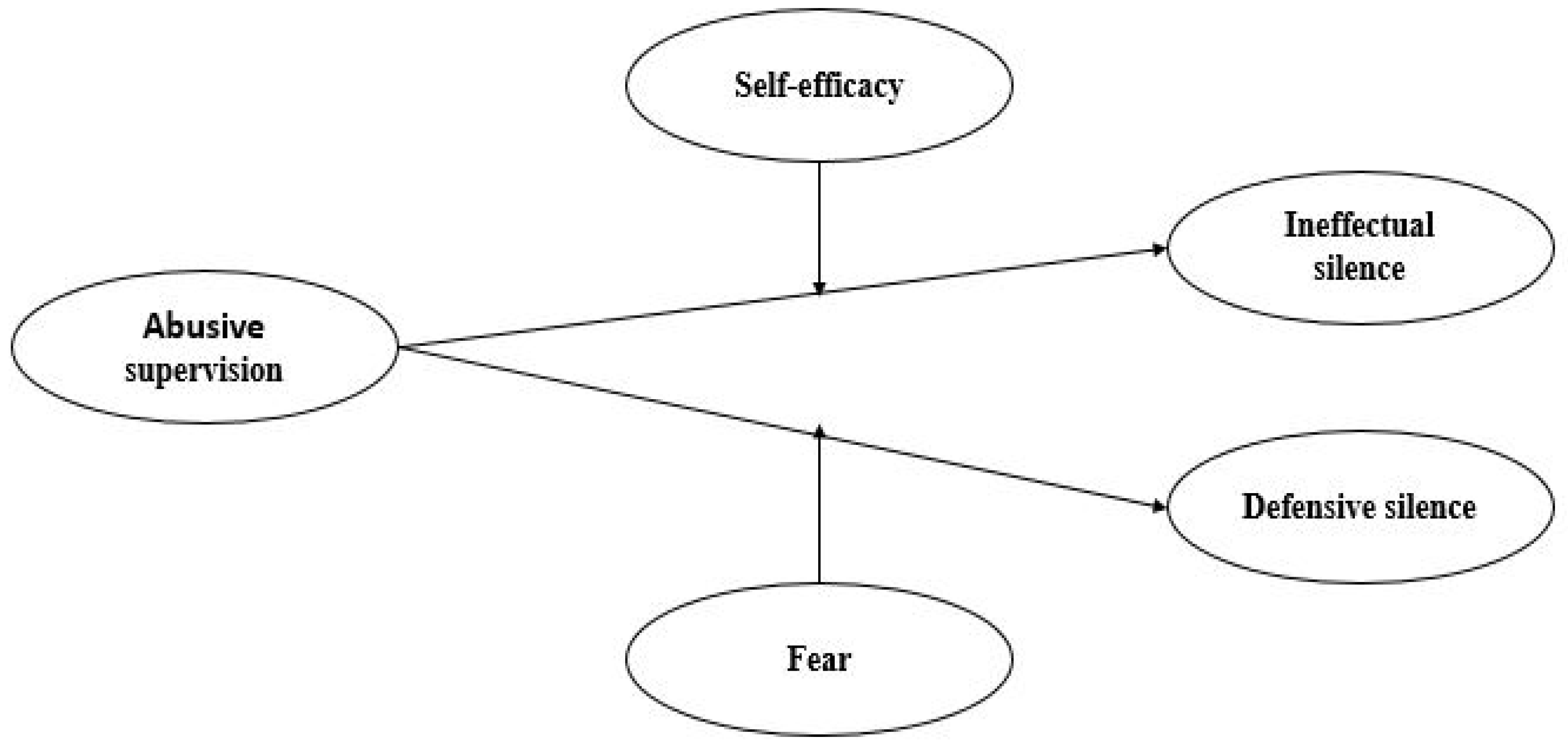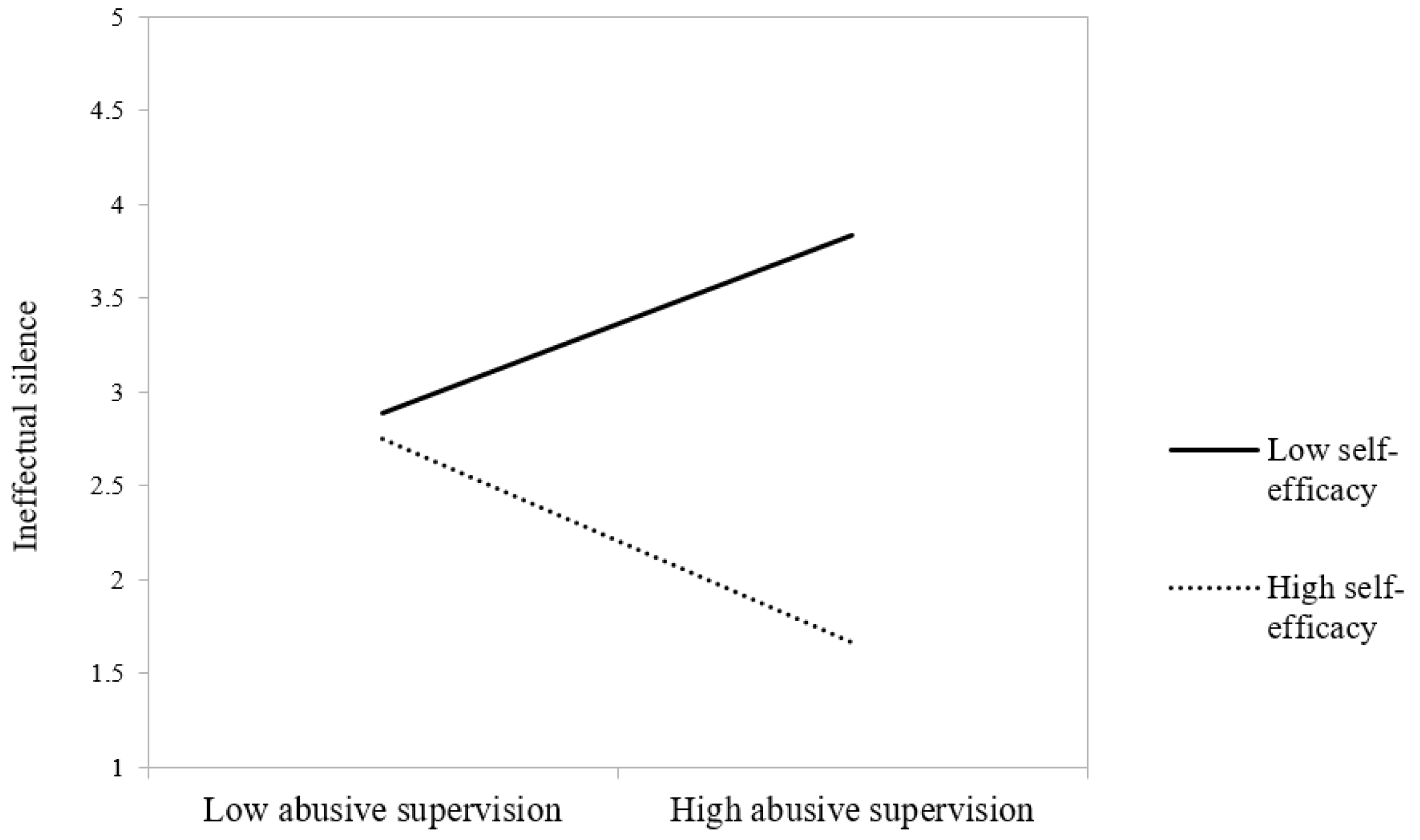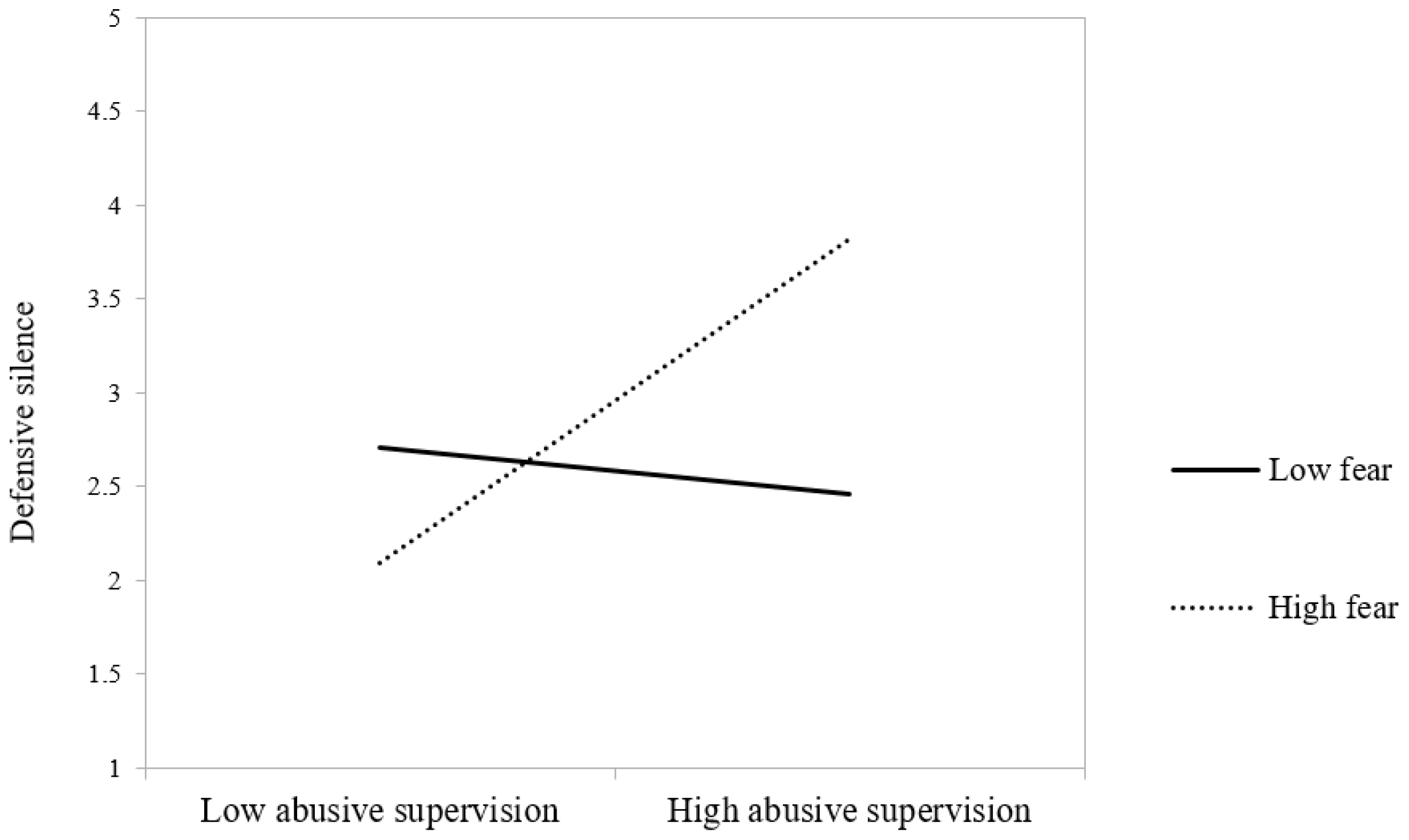When Does Abusive Supervision Foster Ineffectual and Defensive Silence? Employee Self-Efficacy and Fear as Contingencies
Abstract
:1. Introduction
2. Literature Review
Employee Silence
3. Theory and Hypotheses
3.1. Abusive Supervision and Ineffectual Silence
3.2. Moderating Role of Self-Efficacy
3.3. Abusive Supervision and Defensive Silence
3.4. Moderating Role of Fear
4. Methods
4.1. Measures
4.2. Control Variables
4.3. Common Method Bias Test
5. Results
6. Discussion
6.1. Discussion
6.2. Theoretical Contribution
6.3. Practical Implications
6.4. Limitations and Future Research Directions
Author Contributions
Funding
Institutional Review Board Statement
Informed Consent Statement
Data Availability Statement
Conflicts of Interest
References
- Dedahanov, A.T.; Rhee, C.; Yoon, J. Organizational structure and innovation performance: Is employee innovative behavior a missing link? Career Dev. Int. 2017, 22, 334–350. [Google Scholar] [CrossRef]
- Morrison, E.W.; See, K.E.; Pan, C. An approach-inhibition model of employee silence: The joint effects of personal sense of power and target openness. Pers. Psychol. 2015, 68, 547–580. [Google Scholar] [CrossRef]
- Greenberg, J.; Edwards, M.S. Voice and Silence in Organizations; Emerald: Bingley, UK, 2009. [Google Scholar]
- Park, J.H.; Carter, M.Z.; DeFrank, R.S.; Deng, Q. Abusive supervision, psychological distress, and silence: The effects of gender dissimilarity between supervisors and subordinates. J. Bus. Ethics 2018, 153, 775–792. [Google Scholar] [CrossRef]
- Kiewitz, C.; Restubog, S.L.D.; Shoss, M.K.; Garcia, P.R.J.M.; Tang, R.L. Suffering in silence: Investigating the role of fear in the relationship between abusive supervision and defensive silence. J. Appl. Psychol. 2016, 101, 731–742. [Google Scholar] [CrossRef] [Green Version]
- Lam, L.W.; Xu, A.J. Power imbalance and employee silence: The role of abusive leadership, power distance orientation, and perceived organisational politics. Appl. Psychol. 2019, 68, 513–546. [Google Scholar] [CrossRef]
- Tepper, B.J. Abusive supervision in work organizations: Review, synthesis, and research agenda. J. Manag. 2007, 33, 261–289. [Google Scholar] [CrossRef]
- Thau, S.; Bennett, R.J.; Mitchell, M.S.; Marrs, M.B. How management style moderates the relationship between abusive supervision and workplace deviance: An uncertainty management theory perspective. Organ. Behav. Hum. Decis. Processes 2009, 108, 79–92. [Google Scholar] [CrossRef] [Green Version]
- Brislin, R. Understanding Culture’s Influence on Behavior; Harcourt Brace Jovanovich: Fort Worth, TX, USA, 1993. [Google Scholar]
- Pinder, C.C.; Harlos, K.P. Employee silence: Quiescence and acquiescence as responses to perceived injustice. In Research in Personnel and Human Resources Management; Rowland, K.M., Ferris, G.R., Eds.; JAI Press: New York, NY, USA, 2001; pp. 331–369. [Google Scholar]
- Van Dyne, L.; Ang, S.; Botero, I. Conceptualizing employee silence and employee voice as multidimensional constructs. J. Manag. Stud. 2003, 40, 1360–1392. [Google Scholar]
- Jain, A.K.; Srivastava, S.; Cooper, C. A study on the relationship of abusive supervision and fear based silence in India the mediating role of dimensions of emotional intelligence. Curr. Psychol. 2021, 40, 1–16. [Google Scholar] [CrossRef]
- Wang, C.C.; Hsieh, H.H.; Wang, Y.D. Abusive supervision and employee engagement and satisfaction: The mediating role of employee silence. Pers. Rev. 2020, 49, 1845–1858. [Google Scholar] [CrossRef]
- Al-Hawari, M.A.; Bani-Melhem, S.; Quratulain, S. Abusive supervision and frontline employees’ attitudinal outcomes: The multilevel effects of customer orientation. Int. J. Contemp. Hosp. Manag. 2020, 32, 1109–1129. [Google Scholar] [CrossRef]
- Ai-Hua, H.; Yang, L.; Guo-Tao, G. Abusive supervision and employee silence: The mediating effect of perceptions of organizational politics and the moderating effect of LMX. J. Glob. Bus. Insights 2018, 3, 19–37. [Google Scholar] [CrossRef] [Green Version]
- Xu, Q.; Zhao, Y.; Xi, M.; Li, F. Abusive supervision, high-performance work systems, and subordinate silence. Pers. Rev. 2020, 49, 1637–1653. [Google Scholar] [CrossRef]
- Huang, J.; Guo, G.; Tang, D.; Liu, T.; Tan, L. An Eye for an Eye? Third Parties’ Silence Reactions to Peer Abusive Supervision: The Mediating Role of Workplace Anxiety, and the Moderating Role of Core Self-Evaluation. Int. J. Environ. Res. Public Health 2019, 16, 5027. [Google Scholar] [CrossRef] [Green Version]
- Wang, R.J. How abusive supervisors influence employees’ voice and silence: The effects of interactional justice and organizational attribution. J. Soc. Psychol. 2015, 155, 204–220. [Google Scholar] [CrossRef]
- Xu, A.J.; Loi, R.; Lam, L.W. The bad boss takes it all: How abusive supervision and leader–member exchange interact to influence employee silence. Leadersh. Q. 2015, 26, 763–774. [Google Scholar] [CrossRef]
- Pangestu, R.N.; Wulansari, N.A. The effect of abusive supervision on employee silence using emotional exhaustion and organizational justice as a mediation variable. Manag. Anal. J. 2019, 8, 58–67. [Google Scholar]
- Rafferty, A.E.; Restubog, S.L.D. The influence of abusive supervisors on followers’ organizational citizenship behaviours: The hidden costs of abusive supervision. Br. J. Manag. 2011, 22, 270–285. [Google Scholar] [CrossRef]
- Chi, S.C.S.; Liang, S.G. When do subordinates’ emotion-regulation strategies matter? Abusive supervision, subordinates’ emotional exhaustion, and work withdrawal. Leadersh. Q. 2013, 24, 125–137. [Google Scholar] [CrossRef]
- Gray, J.A. A Model for Personality. In A Model for Personality; Eysenck, H.J., Ed.; Springer: New York, NY, USA, 1981; pp. 246–276. [Google Scholar]
- Gibsons, D.E.; Weingart, L.R. Can I do it? Will I try? Personal efficacy, assigned goals, and performance norms as motivators of individual performance. J. Appl. Soc. Psychol. 2001, 31, 624–648. [Google Scholar] [CrossRef]
- Dedahanov, A.T.; Rhee, C.; Gapurjanova, N. Job autonomy and employee voice: Is work-related self-efficacy a missing link? Manag. Decis. 2019, 57, 2401–2413. [Google Scholar] [CrossRef]
- Dedahanov, A.T.; Rhee, J. Examining the relationships among trust, silence and organizational commitment. Manag. Decis. 2015, 53, 1843–1857. [Google Scholar] [CrossRef]
- Brinsfield, C.T. Employee silence motives: Investigation of dimensionality and development of measures. J. Organ. Behav. 2013, 34, 671–697. [Google Scholar] [CrossRef]
- Tepper, B.J. Consequences of abusive supervision. Acad. Manag. J. 2000, 43, 178–190. [Google Scholar]
- Boroff, K.E.; Lewin, D. Loyalty, voice, and intent to exit a union firm: A conceptual and empirical analysis. Ind. Labor Relat. Rev. 1997, 51, 50–63. [Google Scholar] [CrossRef]
- Demiralay, T.; Lorcu, F. Examining Organizational Silence on Doctors with Structural Equation Modeling. Int. J. Bus. Soc. Sci. 2015, 6, 37–49. [Google Scholar]
- Whiteside, D.B.; Barclay, L.J. Echoes of silence: Employee silence as a mediator between overall justice and employee outcomes. J. Bus. Ethics 2013, 116, 251–266. [Google Scholar] [CrossRef]
- Bandura, A. Self-efficacy. In Encyclopedia of Human Behavior, 4th ed.; Ramachaudran, V.S., Ed.; Academic Press: New York, NY, USA, 1997; pp. 71–81. [Google Scholar]
- Walumba, F.O.; Wang, P.; Wang, H.; Schaubroeck, J.; Avolio, B.J. Psychological processes linking authentic leadership to follower behaviors. Leadersh. Q. 2010, 21, 901–914. [Google Scholar] [CrossRef]
- Schlenker, B.R.; Weigold, M.F. Self-identification and accountability. In Impression Management in the Organization Erlbaum; Giacalone, R.A., Rosenfeld, P., Eds.; Psychology Press: Hillsdale, NJ, USA, 1989; pp. 21–43. [Google Scholar]
- Guo, L.; Decoster, S.; Babalola, M.T.; De Schutter, L.; Garba, O.A.; Riisla, K. Authoritarian leadership and employee creativity: The moderating role of psychological capital and the mediating role of fear and defensive silence. J. Bus. Res. 2018, 92, 219–230. [Google Scholar] [CrossRef]
- Milliken, F.J.; Morrison, E.W.; Hewlin, P.F. An exploratory study of employee silence: Issues that employees don’t communicate upward and why. J. Manag. Stud. 2003, 40, 1453–1473. [Google Scholar] [CrossRef]
- Russel, B. Social Research Methods: Qualitative and Quantitative Approaches; Sage: Thousand Oaks, CA, USA, 2000. [Google Scholar]
- Spreitzer, G.M. Psychological empowerment in the workplace: Dimensions, measurement, and validation. Acad. Manag. J. 1995, 38, 1442–1465. [Google Scholar]
- Watson, D.; Clark, L.A. The PANAS-X: Manual for the Positive and Negative Affect Schedule-Expanded Form. 1999. Available online: https://iro.uiowa.edu/esploro/outputs/other/The-PANAS-X-Manual-for-the-Positive/9983557488402771#details (accessed on 5 October 2019).
- Chan, S.C. Paternalistic leadership and employee voice: Does information sharing matter? Hum. Relat. 2014, 67, 667–693. [Google Scholar] [CrossRef]
- Dedahanov, A.T.; Lee, D.; Rhee, J.; Yusupov, S. An examination of the associations among cultural dimensions, relational silence and stress. Pers. Rev. 2016, 45, 593–604. [Google Scholar] [CrossRef]
- Podsakoff, P.M.; MacKenzie, S.B.; Lee, J.; Podsakoff, N.P. Common method biases in behavioral research: A critical review of the literature and recommended remedies. J. Appl. Psychol. 2003, 88, 879–903. [Google Scholar] [CrossRef]
- Kline, R.B. Principles and Practice of Structural Equation Modeling, 3rd ed.; Guilford Press: New York, NY, USA, 2010. [Google Scholar]
- Hair, J.R.; Black, W.C.; Babin, B.J.; Anderson, R.E. Multivariate Data Analysis: A Global Perspective, 7th ed.; Pearson Prentice-Hall: Upper Saddle River, NJ, USA, 2010. [Google Scholar]
- Fornell, C.; Larcker, D.F. Evaluating structural equation models with unobservable variables and measurement error. J. Mark. Res. 1981, 18, 39–50. [Google Scholar] [CrossRef]
- Robinson, S.L.; O’Leary-Kelly, A.M. Monkey see, monkey do: The influence of work groups on the antisocial behavior of employees. Acad. Manag. J. 1998, 41, 658–672. [Google Scholar]
- Dedahanov, A.T.; Lee, D.H.; Rhee, J.; Yoon, J. Entrepreneur’s paternalistic leadership style and creativity: The mediating role of employee voice. Manag. Decis. 2016, 54, 2310–2324. [Google Scholar] [CrossRef] [Green Version]
- Nauta, M.M.; Liu, C.; Li, C. A cross-national examination of self-efficacy as a moderator of autonomy/job strain relationships. Appl. Psychol. 2010, 59, 159–179. [Google Scholar] [CrossRef]



| Variables | Mean | SD | AVE | 1 | 2 | 3 | 4 | 5 | |
|---|---|---|---|---|---|---|---|---|---|
| 1 | Abusive supervision | 3.12 | 1.14 | 0.632 | 1 | ||||
| 2 | Ineffectual silence | 2.96 | 1.41 | 0.849 | 0.108 * | 1 | |||
| 3 | Defensive silence | 2.91 | 1.26 | 0.755 | 0.289 ** | 0.179 ** | 1 | ||
| 4 | Self-efficacy | 2.77 | 1.51 | 0.846 | −0.239 ** | −0.372 ** | −0.015 | 1 | |
| 5 | Fear | 3.17 | 1.32 | 0.753 | 0.128 ** | 0.021 | 0.177 ** | 0.028 | 1 |
| Ineffectual Silence | Defensive Silence | |||||||
|---|---|---|---|---|---|---|---|---|
| Model 1 | Model 2 | Model 3 | Model 4 | Model 1 | Model 2 | Model 3 | Model 4 | |
| Step 1: Control Variables | ||||||||
| Age | 0.073 | 0.080 | 0.081 | 0.054 | 0.028 | 0.044 | 0.058 | 0.045 |
| Gender | −0.063 | −0.065 | −0.075 | −0.036 | −0.061 | −0.066 | −0.060 | −0.085 |
| Work experience | 0.190 | 0.181 | 0.125 | 0.121 | 0.085 | 0.065 | 0.068 | 0.052 |
| Education level | 0.150 | 0.135 | 0.169 | 0.133 | 0.114 | 0.077 | 0.074 | 0.063 |
| Step 2: Main effects | ||||||||
| Abusive Supervision | 0.131 * | 0.025 | 0.029 | 0.316 ** | 0.296 ** | 0.312 ** | ||
| Step 3: Main effects | ||||||||
| Self-efficacy | −0.338 ** | −0.349 ** | ||||||
| Fear | 0.138 * | 0.136 * | ||||||
| Step 4: Interaction | ||||||||
| Ab.Sup X Self-efficacy | −0.237 ** | |||||||
| Ab.Sup X Fear | 0.259 ** | |||||||
| R2 | 0.015 | 0.026 | 0.147 | 0.224 | 0.004 | 0.087 | 0.108 | 0.205 |
| Adjusted R2 | 0.008 | 0.017 | 0.137 | 0.212 | 0.003 | 0.078 | 0.097 | 0.194 |
| Change in R2 | ||||||||
| F | 2.119 | 2.763 | 14.103 | 19.530 | 0.577 | 9.762 | 9.882 | 17.534 |
Publisher’s Note: MDPI stays neutral with regard to jurisdictional claims in published maps and institutional affiliations. |
© 2021 by the authors. Licensee MDPI, Basel, Switzerland. This article is an open access article distributed under the terms and conditions of the Creative Commons Attribution (CC BY) license (https://creativecommons.org/licenses/by/4.0/).
Share and Cite
Dedahanov, A.T.; Abdurazzakov, O.S.; Fayzullaev, A.K.u.; Sun, W. When Does Abusive Supervision Foster Ineffectual and Defensive Silence? Employee Self-Efficacy and Fear as Contingencies. Sustainability 2022, 14, 231. https://doi.org/10.3390/su14010231
Dedahanov AT, Abdurazzakov OS, Fayzullaev AKu, Sun W. When Does Abusive Supervision Foster Ineffectual and Defensive Silence? Employee Self-Efficacy and Fear as Contingencies. Sustainability. 2022; 14(1):231. https://doi.org/10.3390/su14010231
Chicago/Turabian StyleDedahanov, Alisher Tohirovich, Odiljon Sobirovich Abdurazzakov, Abdulkhamid Komil ugli Fayzullaev, and Wei Sun. 2022. "When Does Abusive Supervision Foster Ineffectual and Defensive Silence? Employee Self-Efficacy and Fear as Contingencies" Sustainability 14, no. 1: 231. https://doi.org/10.3390/su14010231
APA StyleDedahanov, A. T., Abdurazzakov, O. S., Fayzullaev, A. K. u., & Sun, W. (2022). When Does Abusive Supervision Foster Ineffectual and Defensive Silence? Employee Self-Efficacy and Fear as Contingencies. Sustainability, 14(1), 231. https://doi.org/10.3390/su14010231






